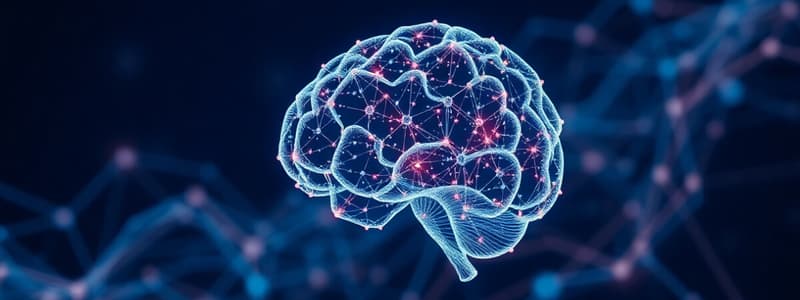Podcast
Questions and Answers
Instance Based learning involves building a model from examples to make predictions.
Instance Based learning involves building a model from examples to make predictions.
False (B)
Model Based learning uses a constructed model to generalize from a set of examples.
Model Based learning uses a constructed model to generalize from a set of examples.
True (A)
Overfitting refers to a scenario where a machine learning model performs well on training data but poorly on unseen data.
Overfitting refers to a scenario where a machine learning model performs well on training data but poorly on unseen data.
True (A)
Nonrepresentative Training Data is considered a challenge in machine learning because it can skew the model's understanding of the overall data distribution.
Nonrepresentative Training Data is considered a challenge in machine learning because it can skew the model's understanding of the overall data distribution.
The only challenge in machine learning related to data is the quantity of training data available.
The only challenge in machine learning related to data is the quantity of training data available.
Linear Regression is a type of unsupervised learning algorithm.
Linear Regression is a type of unsupervised learning algorithm.
K-Means is the only clustering algorithm mentioned in unsupervised learning.
K-Means is the only clustering algorithm mentioned in unsupervised learning.
Machine Learning gives computers the ability to learn from data without being explicitly programmed.
Machine Learning gives computers the ability to learn from data without being explicitly programmed.
Reinforcement Learning agents learn by receiving rewards and penalties based on their actions.
Reinforcement Learning agents learn by receiving rewards and penalties based on their actions.
The main goal of a spam filter created using traditional programming techniques is to flag emails based on the sender’s name alone.
The main goal of a spam filter created using traditional programming techniques is to flag emails based on the sender’s name alone.
Semi-supervised learning does not utilize any unlabeled data.
Semi-supervised learning does not utilize any unlabeled data.
Arthur Samuel is credited with defining the concept of Machine Learning in 1959.
Arthur Samuel is credited with defining the concept of Machine Learning in 1959.
Decision Trees and Random Forests are part of supervised learning algorithms.
Decision Trees and Random Forests are part of supervised learning algorithms.
Machine Learning typically does not require any data for training processes.
Machine Learning typically does not require any data for training processes.
Anomaly detection methods include K-Means clustering.
Anomaly detection methods include K-Means clustering.
Tom Mitchell's definition of Machine Learning emphasizes improvement in performance with respect to a task and experience.
Tom Mitchell's definition of Machine Learning emphasizes improvement in performance with respect to a task and experience.
Support Vector Machines (SVMs) are exclusively used for regression tasks.
Support Vector Machines (SVMs) are exclusively used for regression tasks.
The traditional programming techniques for creating a spam filter involve creating a single detection algorithm.
The traditional programming techniques for creating a spam filter involve creating a single detection algorithm.
Machine Learning systems can automatically adapt to changes over time.
Machine Learning systems can automatically adapt to changes over time.
The primary function of the policy in reinforcement learning is to list all possible actions available to the agent.
The primary function of the policy in reinforcement learning is to list all possible actions available to the agent.
A spam filter that uses a Machine Learning approach does not require testing and refinement.
A spam filter that uses a Machine Learning approach does not require testing and refinement.
Machine Learning is effective for problems requiring minimal hand-tuning or long lists of rules.
Machine Learning is effective for problems requiring minimal hand-tuning or long lists of rules.
Machine Learning systems cannot adapt to fluctuating environments.
Machine Learning systems cannot adapt to fluctuating environments.
The four major categories of Machine Learning are supervised, unsupervised, semi-supervised, and Reinforcement Learning.
The four major categories of Machine Learning are supervised, unsupervised, semi-supervised, and Reinforcement Learning.
In supervised learning, the training data includes solutions that are not labeled.
In supervised learning, the training data includes solutions that are not labeled.
A spam filter is an example of a supervised learning task.
A spam filter is an example of a supervised learning task.
Predicting numeric values in supervised learning requires features known as predictors.
Predicting numeric values in supervised learning requires features known as predictors.
Instance-based learning compares new data points with known data points, while model-based learning identifies patterns in training data.
Instance-based learning compares new data points with known data points, while model-based learning identifies patterns in training data.
Both online and batch learning refer to systems that require strict supervision during the entire learning process.
Both online and batch learning refer to systems that require strict supervision during the entire learning process.
Batch learning allows a system to learn incrementally from a stream of incoming data.
Batch learning allows a system to learn incrementally from a stream of incoming data.
Online learning can be described as training a system incrementally by feeding it data instances in small groups.
Online learning can be described as training a system incrementally by feeding it data instances in small groups.
In offline learning, the system can update its knowledge as new data becomes available.
In offline learning, the system can update its knowledge as new data becomes available.
Instance-based learning focuses on generalizing from a limited set of training examples.
Instance-based learning focuses on generalizing from a limited set of training examples.
Model-based learning requires extensive computational resources and time to adjust to new data.
Model-based learning requires extensive computational resources and time to adjust to new data.
Online learning is typically performed in batch mode, using all available data at once.
Online learning is typically performed in batch mode, using all available data at once.
The performance measure on training data is sufficient to ensure good generalization to new instances.
The performance measure on training data is sufficient to ensure good generalization to new instances.
Mini batches are a method used in both online and batch learning to process data.
Mini batches are a method used in both online and batch learning to process data.
Flashcards
Machine Learning (ML)
Machine Learning (ML)
Programming computers to learn from data without explicit instructions.
ML experience
ML experience
The data used to train a machine learning model, impacting its performance on a task.
ML task
ML task
The specific job a machine learning system is designed to perform.
ML performance measure
ML performance measure
Signup and view all the flashcards
Traditional spam filtering
Traditional spam filtering
Signup and view all the flashcards
ML spam filtering
ML spam filtering
Signup and view all the flashcards
Adapting to changes
Adapting to changes
Signup and view all the flashcards
Human learning via ML
Human learning via ML
Signup and view all the flashcards
Regression
Regression
Signup and view all the flashcards
Supervised Learning
Supervised Learning
Signup and view all the flashcards
Unsupervised Learning
Unsupervised Learning
Signup and view all the flashcards
K-Nearest Neighbors
K-Nearest Neighbors
Signup and view all the flashcards
Linear Regression
Linear Regression
Signup and view all the flashcards
Clustering
Clustering
Signup and view all the flashcards
Anomaly Detection
Anomaly Detection
Signup and view all the flashcards
Semi-supervised Learning
Semi-supervised Learning
Signup and view all the flashcards
Machine Learning
Machine Learning
Signup and view all the flashcards
Classification
Classification
Signup and view all the flashcards
Prediction
Prediction
Signup and view all the flashcards
Labelled outcomes
Labelled outcomes
Signup and view all the flashcards
Predictors
Predictors
Signup and view all the flashcards
Training Data
Training Data
Signup and view all the flashcards
Batch Learning
Batch Learning
Signup and view all the flashcards
Online Learning
Online Learning
Signup and view all the flashcards
Offline Learning
Offline Learning
Signup and view all the flashcards
Instance-Based Learning
Instance-Based Learning
Signup and view all the flashcards
Model-Based Learning
Model-Based Learning
Signup and view all the flashcards
Generalization in ML
Generalization in ML
Signup and view all the flashcards
What does the system learn from?
What does the system learn from?
Signup and view all the flashcards
Performance on New Data
Performance on New Data
Signup and view all the flashcards
Insufficient Training Data
Insufficient Training Data
Signup and view all the flashcards
Nonrepresentative Training Data
Nonrepresentative Training Data
Signup and view all the flashcards
Overfitting the Training Data
Overfitting the Training Data
Signup and view all the flashcards
Study Notes
Introduction to Machine Learning
- Machine learning (ML) is the science (and art) of programming computers to learn from data.
- ML gives computers the ability to learn without explicit programming.
- A program learns from experience with respect to a task T and a performance measure P, improving with experience E.
Objectives
- What is machine learning?
- Why use machine learning?
- Types of machine learning systems
Why Use Machine Learning?
- Traditional programming approach to spam filtering requires detailed rules for each pattern. ML-based spam filters learn these patterns from data.
- The ML approach involves studying the problem, training an algorithm with data, evaluating the solution, and analyzing errors, iterating until it is sufficient.
- ML systems can adapt to changing data, unlike traditional rule-based systems which are fixed.
Types of Machine Learning Systems
- Supervised Learning: The training data includes desired outputs (labels). Examples include classification (e.g., spam filter) and regression (e.g., predicting car prices).
- Unsupervised Learning: The training data is unlabeled. Examples include clustering (grouping similar data points) and anomaly detection.
- Semi-supervised Learning: A combination of supervised and unsupervised learning, using both labeled and unlabeled data.
- Reinforcement Learning: The system learns through trial and error by interacting with an environment and receiving rewards or penalties.
Supervised Learning Algorithms
- k-Nearest Neighbors
- Linear Regression
- Logistic Regression
- Support Vector Machines (SVMs)
- Decision Trees and Random Forests
- Neural Networks
Unsupervised Learning
- Methods include clustering, anomaly detection, and hierarchical cluster analysis (HCA)
- Algorithms like K-Means, DBSCAN, One-class SVM, and Isolation Forest.
Clustering
- A method of grouping similar data points into clusters based on their features.
Anomaly Detection
- Identifying unusual or abnormal data points in a dataset.
Semi-supervised learning
- Uses both labeled and unlabeled data to train models.
Reinforcement Learning
- A system learns by interacting with an environment and receiving feedback in the form of rewards or penalties. The goal is to learn an optimal strategy (policy) that maximizes cumulative rewards.
Batch vs Online Learning
- Batch learning: Training the system with all the data at once, typically offline. It does not adapt to new data easily.
- Online learning: Training the system incrementally, using new data as it arrives. Can adapt to new data on the fly.
- Offline Learning = Batch Learning.
Instance-Based vs Model-Based Learning
- Instance-based learning: The system memorizes the training examples and uses them for predictions.
- Model-based learning: The system builds a model or representation of the training data to make predictions.
Main Challenges of Machine Learning
- Insufficient quantity of training data.
- Nonrepresentative training data.
- Poor quality data.
- Irrelevant features.
- Overfitting the training data.
- Underfitting the training data.
- Stepping Back.
- Testing and validation.
Studying That Suits You
Use AI to generate personalized quizzes and flashcards to suit your learning preferences.




